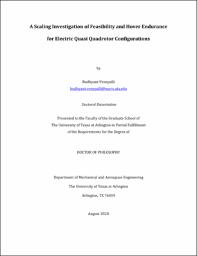
ATTENTION: The works hosted here are being migrated to a new repository that will consolidate resources, improve discoverability, and better show UTA's research impact on the global community. We will update authors as the migration progresses. Please see MavMatrix for more information.
Show simple item record
| dc.contributor.advisor | Dancila, Dragos Stefan | |
| dc.creator | Venepalli, Budhyant | |
| dc.date.accessioned | 2020-09-10T18:15:20Z | |
| dc.date.available | 2020-09-10T18:15:20Z | |
| dc.date.created | 2020-08 | |
| dc.date.issued | 2020-08-05 | |
| dc.date.submitted | August 2020 | |
| dc.identifier.uri | http://hdl.handle.net/10106/29437 | |
| dc.description.abstract | Motivated by recent developments in distributed propulsion electric vehicles, an effort is made in the present study to numerically investigate the upper bound of hover endurance achievable by electric quasi-quadrotors at various mass scales in the range of 0.1 kg to 10000 kg total vehicle mass.
A feasible rotor propulsion pod design space is determined considering physics-based conceptual design constraints defined by blade tip Mach number and Reynolds number to ensure effective and energy-efficient generation of lift.
A conceptual level scaling optimization for two-bladed rotor quasi-quadrotors was carried out at constant blade tip speed. A momentum theory model, a blade element theory model, and a blade element momentum theory model, respectively, were used to calculate the hover endurance for an electric propulsor pod, defined as a vertically stacked configuration of a fixed pitch solid blade carbon fiber rotor, driven by a state of the art permanent magnet motor, and powered by a state of the art Li-ion battery.
Results obtained show that on the one hand individual propulsor pods which are too small cannot be optimal in hover, as the low Reynolds number has adverse effects on aerodynamics. On the other hand, pods that are too large cannot be optimal in hover as the blade mass penalty increases. It is consequently found that an optimal propulsor pod size exists, for which the hover endurance is optimal. Hence, results show that modular, endurance optimal design is achievable for larger vehicles using multiple optimal pods while preserving the optimal endurance. | |
| dc.format.mimetype | application/pdf | |
| dc.language.iso | en_US | |
| dc.subject | Electric VTOL | |
| dc.subject | Multirotor | |
| dc.subject | Hover nndurance | |
| dc.subject | Blade element momentum theory | |
| dc.subject | Optimization | |
| dc.subject | Sequential quadratic programming | |
| dc.title | A Scaling Investigation of Feasibility and Hover Endurance for Electric Quasi Quadrotor Configurations | |
| dc.type | Thesis | |
| dc.degree.department | Mechanical and Aerospace Engineering | |
| dc.degree.name | Doctor of Philosophy in Aerospace Engineering | |
| dc.date.updated | 2020-09-10T18:15:20Z | |
| thesis.degree.department | Mechanical and Aerospace Engineering | |
| thesis.degree.grantor | The University of Texas at Arlington | |
| thesis.degree.level | Doctoral | |
| thesis.degree.name | Doctor of Philosophy in Aerospace Engineering | |
| dc.type.material | text | |
| dc.creator.orcid | 0000-0002-6787-3274 | |
Files in this item
- Name:
- VENEPALLI-DISSERTATION-2020.pdf
- Size:
- 3.300Mb
- Format:
- PDF
This item appears in the following Collection(s)
Show simple item record


